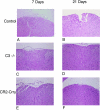Complement plays an important role in spinal cord injury and represents a therapeutic target for improving recovery following trauma
- PMID: 16936276
- PMCID: PMC1698827
- DOI: 10.2353/ajpath.2006.060248
Complement plays an important role in spinal cord injury and represents a therapeutic target for improving recovery following trauma
Abstract
Initiation of an inflammatory cascade following traumatic spinal cord injury (SCI) is thought to cause secondary injury and to adversely impact functional recovery, although the mechanisms involved are not well defined. We report on the dynamics of complement activation and deposition in the mouse spinal cord following traumatic injury, the role of complement in the development of SCI, and the characterization of a novel targeted complement inhibitor. Following traumatic injury, mice deficient in C3 had a significantly improved locomotor score when compared with wild-type controls, and analysis of their spinal cords revealed significantly more tissue sparing, with significantly less necrosis, demyelination, and neutrophil infiltration. Wild-type mice were also treated with CR2-Crry, a novel inhibitor of complement activation that targets to sites of C3 deposition. A single intravenous injection of CR2-Crry 1 hour after traumatic injury improved functional outcome and pathology to an extent similar to that seen in C3-deficient animals. CR2-Crry specifically targeted to the injured spinal cord in a distribution pattern corresponding to that seen for deposited C3. As immunosuppression is undesirable in patients following SCI, targeted CR2-Crry may provide appropriate bioavailability to treat SCI at a dose that does not significantly affect systemic levels of serum complement activity.
Figures







Similar articles
-
A new treatment for neurogenic inflammation caused by EV71 with CR2-targeted complement inhibitor.Virol J. 2012 Nov 23;9:285. doi: 10.1186/1743-422X-9-285. Virol J. 2012. PMID: 23173749 Free PMC article.
-
Complement-dependent P-selectin expression and injury following ischemic stroke.J Immunol. 2006 Nov 15;177(10):7266-74. doi: 10.4049/jimmunol.177.10.7266. J Immunol. 2006. PMID: 17082645
-
A complement C3 inhibitor specifically targeted to sites of complement activation effectively ameliorates collagen-induced arthritis in DBA/1J mice.J Immunol. 2007 Dec 1;179(11):7860-7. doi: 10.4049/jimmunol.179.11.7860. J Immunol. 2007. PMID: 18025232
-
Complement and spinal cord injury: traditional and non-traditional aspects of complement cascade function in the injured spinal cord microenvironment.Exp Neurol. 2014 Aug;258:35-47. doi: 10.1016/j.expneurol.2014.04.028. Exp Neurol. 2014. PMID: 25017886 Review.
-
Structure and function of the complement receptors, CR1 (CD35) and CR2 (CD21).Adv Immunol. 1989;46:183-219. doi: 10.1016/s0065-2776(08)60654-9. Adv Immunol. 1989. PMID: 2551147 Review. No abstract available.
Cited by
-
Complement activation in the injured central nervous system: another dual-edged sword?J Neuroinflammation. 2012 Jun 21;9:137. doi: 10.1186/1742-2094-9-137. J Neuroinflammation. 2012. PMID: 22721265 Free PMC article. Review.
-
Inhibition of the alternative complement activation pathway in traumatic brain injury by a monoclonal anti-factor B antibody: a randomized placebo-controlled study in mice.J Neuroinflammation. 2007 May 2;4:13. doi: 10.1186/1742-2094-4-13. J Neuroinflammation. 2007. PMID: 17474994 Free PMC article. Clinical Trial.
-
The complement cascade: Yin-Yang in neuroinflammation--neuro-protection and -degeneration.J Neurochem. 2008 Dec;107(5):1169-87. doi: 10.1111/j.1471-4159.2008.05668.x. Epub 2008 Oct 24. J Neurochem. 2008. PMID: 18786171 Free PMC article. Review.
-
The role of the complement system in Multiple Sclerosis: A review.Front Immunol. 2022 Aug 10;13:970486. doi: 10.3389/fimmu.2022.970486. eCollection 2022. Front Immunol. 2022. PMID: 36032156 Free PMC article. Review.
-
Acute inflammatory profiles differ with sex and age after spinal cord injury.J Neuroinflammation. 2021 May 13;18(1):113. doi: 10.1186/s12974-021-02161-8. J Neuroinflammation. 2021. PMID: 33985529 Free PMC article.
References
-
- Kwon BK, Tetzlaff W, Grauer JN, Beiner J, Vaccaro AR. Pathophysiology and pharmacologic treatment of acute spinal cord injury. Spine J. 2004;4:451–464. - PubMed
-
- Taoka Y, Okajima K, Uchiba M, Murakami K, Kushimoto S, Johno M, Naruo M, Okabe H, Takatsuki K. Role of neutrophils in spinal cord injury in the rat. Neuroscience. 1997;79:1177–1182. - PubMed
-
- Fiore C, Inman DM, Hirose S, Noble LJ, Igarashi T, Compagnone NA. Treatment with the neurosteroid dehydroepiandrosterone promotes recovery of motor behavior after moderate contusive spinal cord injury in the mouse. J Neurosci Res. 2004;75:391–400. - PubMed
-
- Tsai EC, Tator CH. Neuroprotection and regeneration strategies for spinal cord repair. Curr Pharm Des. 2005;11:1211–1222. - PubMed
Publication types
MeSH terms
Substances
LinkOut - more resources
Full Text Sources
Medical
Molecular Biology Databases
Research Materials
Miscellaneous

